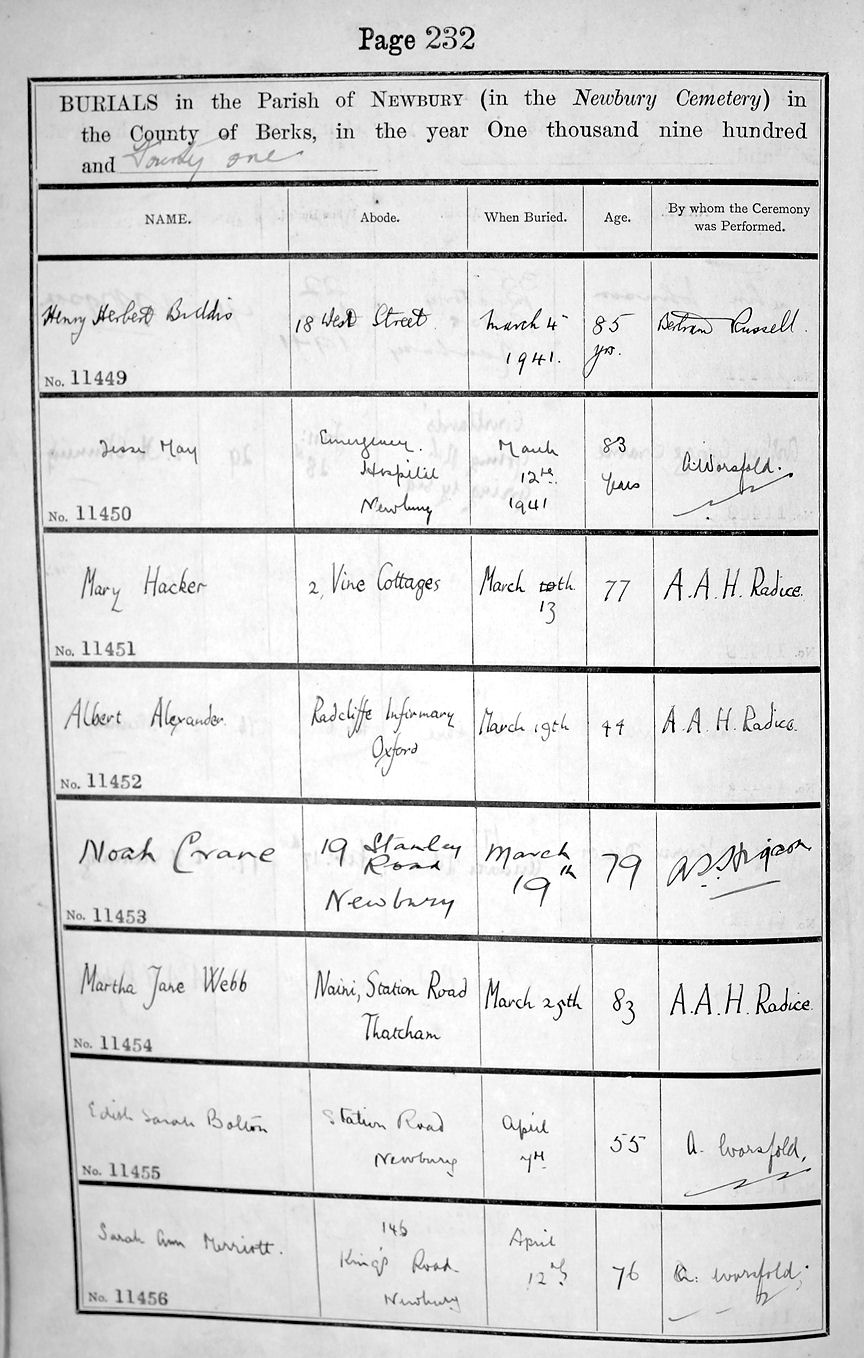
Personal Details of Albert Alexander
| Born: | |
| Died: | |
| Buried: | 19/03/1941 |
Listed below are all the details we have been able to find so far on Albert Alexander.
As far as we are aware, all the information is correct. However, sometimes transcriptions can lead to errors being made. If you find any errors or omissions, please let us know and we will endeavour to get them corrected as soon as possible.
If you have any further information on Albert Alexander, we would be delighted to hear from you.
Birth
There is no information in our database regarding the birth of Albert Alexander.
Can you help us? If so, please contact our History Research Group.
Death
| Name at death | Albert Alexander | ||||||||||
| Date of death | |||||||||||
| Age at death | 44 | ||||||||||
| Gender at Death | Male | ||||||||||
| Cause of Death | perforated gastric ulcer staphylococcal pyemia | ||||||||||
| Place of Death | Radcliffe Infirmary, Oxford Oxford | ||||||||||
| Usual Address | |||||||||||
| GRO certificate index |
|
||||||||||
| Information Sources | General Register Office |

Death certificate for Albert Alexander*
Provided by FNRC
Burial Register
| Name at death | Albert Alexander | ||||||
| Age at Death | 44 | ||||||
| Burial Date | 19 March 1941 | ||||||
| Abode |
Radcliffe Infirmary
Oxford |
||||||
| Official at Burial | A.A.H.Radice | ||||||
| Comments | |||||||
| Burial Register Index |
|
||||||
| Sources | Burial Register |
Memorial Details
| On headstone: In/Loving Memory of /Albert Alexander, / died March 15. 1941/ aged 44./ At rest./Edith Mary / Alexander/ his wife/ died October 10. 1985 / aged 89.// | |
| Name on Memorial | Albert Alexander |
| Date of death | 15/03/1941 |
| Age | 44 |
| Gender | Male |
| Memorial Type | Kerbstones with headstone at E end |
| Construction Material | Granite |
| Condition of memorial | Kerbstones with corner pillars and headstone at E end |
| Pattison Location Code | Ch32 |
| Others named on memorial | |
| Edith Mary Alexander |
Newspaper Cuttings
The articles below have been transcribed from newspapers and magezines.
Albert Alexander
| Source: | The National Association of Retired Police Officers |
| Article date: | 01/01/2004 |
| Copyright: | as above |
| Transciption: | Oxon NARPO* News - Spring 2004
Albert Alexander
During 1940 research was in progress on a drug known as penicillin. A number of experiments had been carried out on animals with some success and it was decided to risk a clinical trial. The team did not want to risk injecting a healthy volunteer in case of adverse reaction. It would be a constable from the Berkshire Constabulary.
Police Constable 231 Albert Alexander was a member of the Berkshire Constabulary. He was born in the parish of Woodley in February 1897, joined the Force in July 1921.
At the outbreak of the war he was stationed at Wootton and was a member of the Force’s Mutual Aid Team and was on standby duty to go anywhere in the Country.
At about 7 pm on 23 November 1940 men from the County were required to assist the Southampton police. Thirty men were mustered, one of whom was Constable Alexander. They reported to the Civic centre in Southampton. Upon their arrival there were sporadic raids, but the following week was comparatively quiet. Their time was spent on patrol and surveillance of damaged buildings.
At approximately 5:50 pm on 30 November a surprise attack came. A police station took a direct hit killing a sergeant and injuring two constables, one of whom was Constable Alexander. After treatment he was transferred to Abingdon Cottage Hospital where he developed blood poisoning. He was moved to the Radcliffe Infirmary Oxford for treatment. It was agreed that he would be injected with the drug penicillin. His condition improved as a result of the drug, but after 5 days the supply ran out and a month later he died. The problem of manufacture was taken up by the Americans.
The method they used to grow the cultures was in hundreds of BEDPANS.
* NAPRO is The National Association of Retired Police Officers. |
| This obituary entry is awaiting verification. |
DEATH OF P.C. ALEXANDER
| Source: | Newbury Weekly News |
| Article date: | |
| Copyright: | Newbury Weekly News |
| Transciption: | DEATH OF P.C. ALEXANDER Police officers from all parts of the County attended the funeral, which took place yesterday (Wednesday) at the Newtown-road Cemetery, Newbury, where a service was conducted by the Rev. A.A.H. Radice. The family mourners were: the widow, Mr. and Mrs. Alexander (brother and sister-in-law), Mr. And Mrs. G. Annetts (sister and brother-in-law), Mrs. E. Annetts (sister), Mr and Mrs Daws (sister and brother-in-law), Mrs. Lucas, Mrs. Hughes sisters-in-law, Mr. Deacon (brother-in-law), Mrs Crawshaw, Miss Crawshaw, Mr. Bowley. There were also present: Supt Crombie, Reading (representing the Chief Constable), Supt Barrett (Abingdon) Supt. Lambourn (Newbury), Inspector Bennett (Newbury), Inspector Burbidge (Faringdon), Inspector East (Wokingham), Inspector Hayter (Abingdon), Inspector Haskins (Maidenhead), Inspector Lidsey (Didcot), Sixteen police sergeants and 54 constables attended in addition to Section Officer Hough and three special constables from Cumnor. Wreaths were sent from his wife and children; Sheila and Brian; Daisy, Gwen and Jack; Gran; Nin, Whoop and Humphrey; Sid Kit and Monica; Neil, Mabel, Joe, Dorrie and Harry; Peggy and Fred; Eve and George (Shinfield), and Ted and Neil (Burghfield); Phil, Daisy and family;All at Homer Cottage; Four Neighbours; Friends at “The Bystander”; Mr. Trinder, Edith and Margery; Mr. and Mrs. Sayer and Ken; Mr. and Mrs. Binning and family; Inspector and Mrs Huckins;Mr. And Mrs. G. Tomkins; Mr. and Mrs. Moreton and John; Mr. and Mrs Meadows and family; Mr. and Mrs. Buzzard and family;Mr. And Mrs. Rowse and family; Mr. and Mrs. G.S. Gooden; Mr. and Mrs. Wing, Cumnor Post Office,Mr. And Mrs. Brewer and family; Children and teachers of Dry Sanden School; Home Guards of Wootton-road; White Hill Dairy; Air Raid Wardens, Lower Wootton; Chief Constable, Officers and Constables of the Berkshire Constabulary; Officers and Constables of the Newbury Division; Cumnor Police and Special Constables; Comrades of the Abingdon Division; Officers and Constables of the Maidenhead Division; Officers and Constables of the Wokingham Division.
FOOTNOTE:
Since the inclusion on our website of details of P.C. Alexander’s death we have been contacted by the following international institutions seeking further assistance.
1. MUSEU DO UNIVERSO DA FARMACIA, BRAZIL
Working on a mini-documentary about the history of penicillin
2. SCIENCE MUSEUM, LONDON
Working alongside India’s National Council of Science Museums in setting up an exhibition to tour India and three other countries. Funding is by The Wellcome Trust.
Also inclusion in the public exhibition at the Science Museum, Kensington, in the Wellcome Gallery.
3. THE CENTER FOR EDUCATIONAL TECHNOLOGY, ISRAEL
Developing an online educational course in microbiology for high school students in both Hebrew and Arabic.
4. JEFFREY BIOMEDICAL RESEARCH CENTRE, CAMBRIDGE
Setting up a free online educational exhibition around the history of scientific tools, etc. hosted by WhatisBiotechnology.org, a charitable educational resource.
Gratifying isn’t it!
|
Albert Alexander
| Source: | Paul Thompson |
| Article date: | 01/03/2020 |
| Copyright: | FNRC |
| Transciption: | NOTE: WELLCOME GALLERY, SCIENCE MUSEUM You may be aware that toward the end of last year, we were contacted by the London Science Museum about Albert Alexander (the first person in the UK to receive experimental penicillin treatment) who is buried in the cemetery. They were planning a large display on medicines and had seen our material on Albert and wanted to use some of it in a special display on penicillin as part of the exhibition. We agreed and liaised with Albert’s family for the use of the photographs that we have on site by kind permission. I am pleased to say that the exhibition is now open in the “Wellcome Gallery” and I have recently been to see it. Albert’s is a small part of the display, but he played a major role in the development of penicillin and we are proud to have played our part helping to create this interesting exhibition. Admission to the Science Museum is still free if you are up that way. |
| This obituary entry is awaiting verification. |
Albert Alexander
| Source: | “One Hundred Years - Berkshire Constabulary: 1856 - 1956” Sgt. Bill Indge | |
| Article date: | 01/01/1956 | |
| Copyright: | as above | |
| Transciption: |
|
|
| This obituary entry is awaiting verification. |
1939 census
| Source: | 1939 census |
| Article date: | |
| Copyright: | |
| Transciption: | Shows Albert and his family living at 17 Cumnor Road, Abingdon. See photos of entry below |
| This obituary entry is awaiting verification. |
GOTM Albert Alexander FONRC
| Source: | FONRC |
| Article date: | 08/07/2023 |
| Copyright: | |
| Transciption: | Grave of the Month - Albert Alexander The grave of the month for July just has to be Albert Alexander! Constable Albert Alexander had been posted to Southampton in 1941 to assist the local police after a period of bombing. The police station took a direct hit, killing a sergeant and injuring two constables, one of whom was Albert. After treatment he was transferred to Abingdon Cottage Hospital where he developed blood poisoning. He was moved to the Radcliffe Infirmary Oxford for treatment. It was agreed that he would be injected with the drug penicillin. His condition improved as a result of the drug, but after 5 days the supply ran out and a month later, he died on the 15th March 1941 and was buried in NRC on the 19th March 1941. Newtown Road Cemetery received a visit on the 29th of June from his daughter Sheila LeBlanc and his granddaughters Linda Willison and Karen LeBlanc who had all flown from California specially for this event, to view the blue plaque in Carnarvon Place to Albert’s memory and to attend as guests the World Congress of Pharmacology in Glasgow. The Mayor and Mayoress, Nigel Foot and Sarah Slack, Thames Valley Police A/Chief Inspector, Andrew Hunt and Professor Mike Barrett from Glasgow University attended together with Dave Stubbs and various Friends of the cemetery. The event was covered by the BBC, NWN and several other photographers.
Sheila LeBlanc, who was 8, when her father died in 1941, laid flowers on her father’s grave. Brian Sylvester presented Sheila with a miniature set of her father’s war medals. Karen LeBlanc, Linda Willison and Sheila LeBlanc at Albert Alexanders graveside. Left to right. |
| This obituary entry is awaiting verification. |
True story of penicillin’s first patient
| Source: | Bill Sullivan |
| Article date: | 17/04/2022 |
| Copyright: | Bill Sullivan |
| Transciption: | Here’s the true story of penicillin’s first patient
April 17, 2022 Albert Alexander was dying. World War II was raging, and this police officer of the county of Oxford, England, had developed a severe case of sepsis after a cut on his face became badly infected. His blood was now teeming with deadly bacteria. According to his physician, Charles Fletcher, Alexander was in tremendous pain, “desperately and pathetically ill.” The bacterial infection was eating him alive: He’d already lost one eye and had oozing abscesses all over his face and in his lungs.
Courtesy of Linda Willason, CC BY-ND Albert Alexander in uniform. Since all known treatment options were exhausted and death appeared imminent, Fletcher decided that Alexander was the perfect candidate to try a new, experimental therapy. On Feb. 12, 1941, Alexander became the first known person to be treated with penicillin. Within days he began to make a stunning recovery. I am a professor of pharmacology, and Alexander’s story is the prelude to my yearly lecture on antibiotics. Like many other microbiology instructors, I’d always told students that Alexander’s septicemia arose after he scratched his cheek on a thorn while pruning rosebushes. This popular account dominates the scientific literature as well as recent articles and books. The problem is, while descriptions of the miraculous effect of penicillin in this case are accurate, the details of Alexander’s injury were muddled, likely by wartime propaganda. |
| This obituary entry is awaiting verification. |
Pictures and photographs
The pictures below are all linked with Albert Alexander.
Click an image to show an enlarged version of it.
Albert Alexander
© with permission of the Sir William Dunn School of Pathology
Albert Alexander
© with permission of the Sir William Dunn School of Pathology

Albert Alexander
© Linda Leblanc
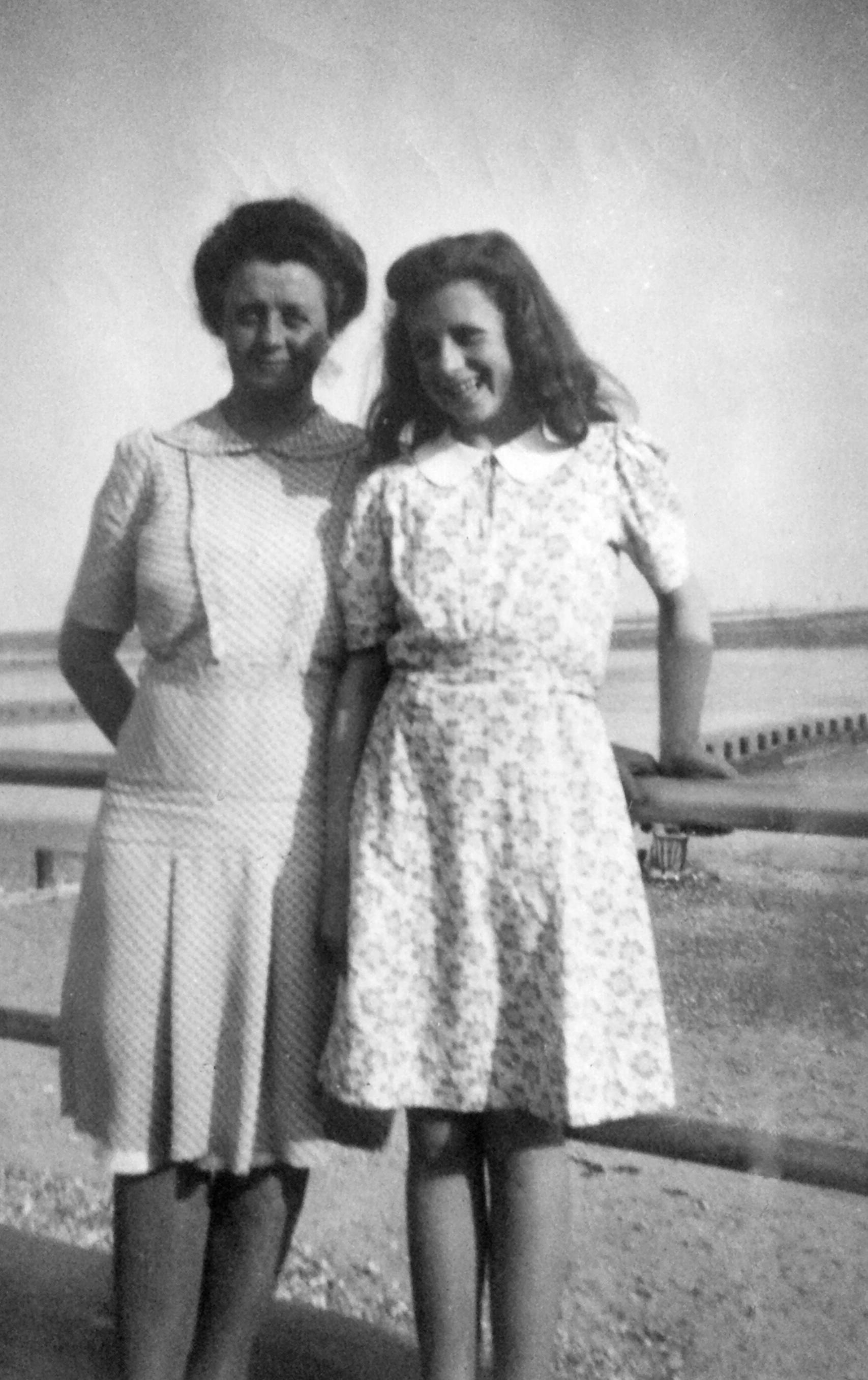
Edith Alexander
© Linda Leblanc
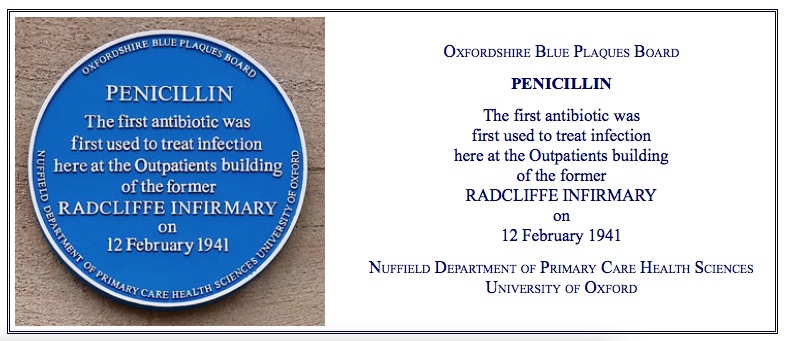
Albert Alexander
© Oxfordshire Bolue Plaques Board
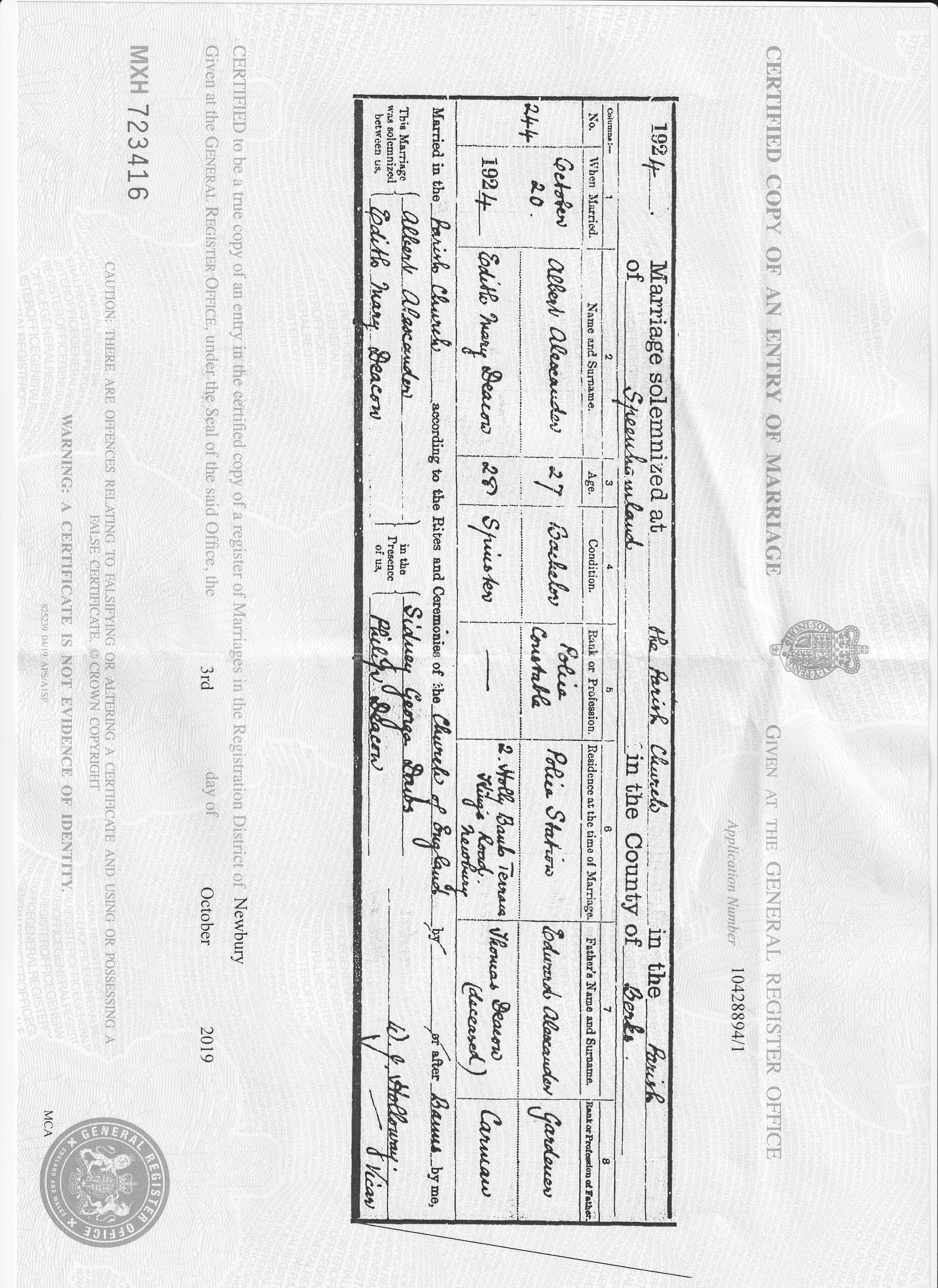
Albert Alexander
© General Register Office
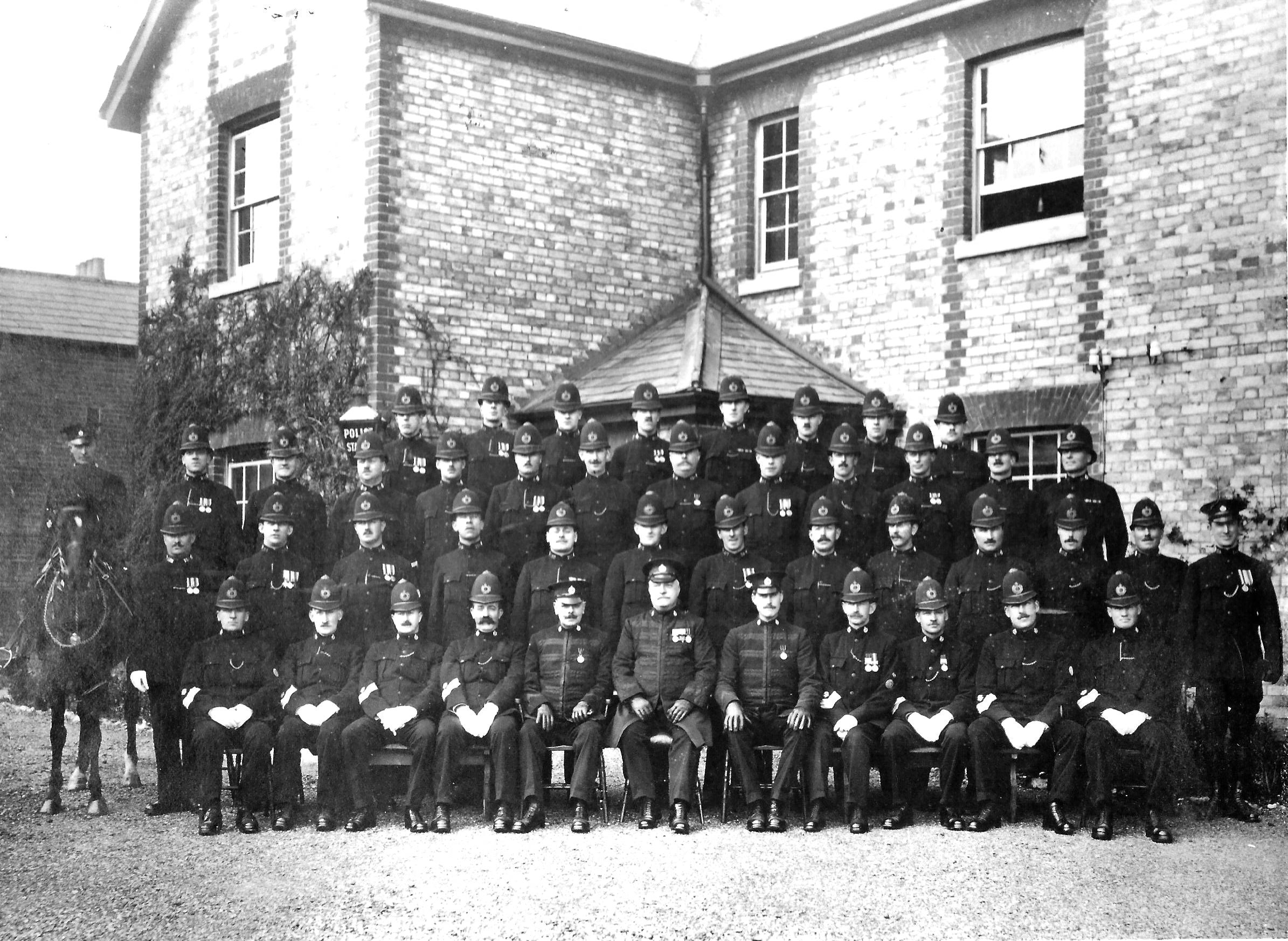
Albert Alexander
© kindly provided by David Stubbs - Albert Alexander is towards the back on the left-hand side between the window and the mounted officer.

Albert Alexander 1939 c
©
Sheila LeBlanc Albert's daughter visiting 29/06/2023
©
Karen LeBlanc, Linda Willason (Granddaughters), Sheila LeBlanc (daughter) visiting grave of Albert Alexander 29/06/2023 from California
©
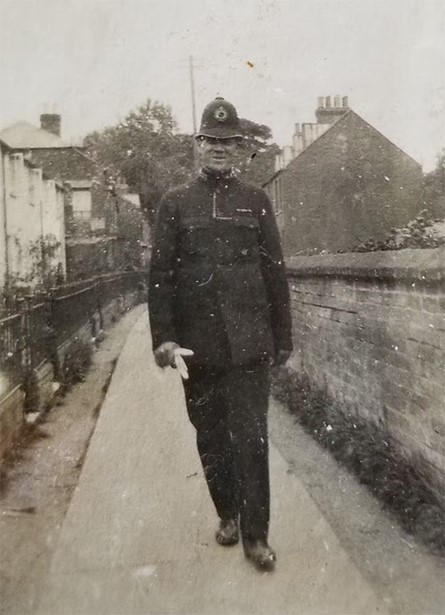
Albert Alexander in Police Uniform
© Linda Willason
Albert Alexander grave
© fnrc
Biographical Information
The articles below contain information about Albert Alexander.
Penicillin Man
Penicillin Man
Through the website we were asked whether we could locate the grave of Albert Alexander. The enquirer already had a photo but was hoping to come and visit the grave. Luckily this grave was easily found as it is on the right-hand side of the curved path between the gate and the Chapel – about nine graves along from Mrs King’s grave outside the Chapel.
Intrigued I asked why he was interested in Mr Alexander.
The story was that in December 1940 Constable Alexander, a Newbury man, but living in Oxford, was scratched on his mouth by a rose thorn (see correction below). Infection set in and by January 1941 Albert was hospitalised in the Radcliffe Infirmary. His face became so matted with weeping red abscesses that one of his eyes had to be removed. The infection had spread to his lungs. He had no hope at all.
Meanwhile Howard Florey and Ernst Chain, Oxford scientists, had been developing supplies of penicillin mould and had experimented successfully on mice. They were now ready to try this new wonder drug out on a human being. They had no idea whether it would kill or cure. With the help of a young doctor, Charles Fletcher, Albert Alexander became the first patient to be treated with penicillin. Within 24 hours his condition was greatly improved, his temperature was normal and his appetite had returned. However, at this point the penicillin supply ran out. For several days the team recycled Albert Alexander’s urine to recover as much penicillin as possible but to no avail; after a week they ran out of the drug, anmd despite the recycling, Alexander died on 14th March.
And he is buried in Newtown Road Cemetery!
Dr Tim Walter who advises us on medical matters remembers hearing the urine recycling story in medical school but of course had no idea Alexander was buried at the end of the road. The next patient treated recovered completely and as we know penicillin went on to be the magic bullet which has saved thousands of lives since 1941. Albert Alexander did not die in vain.
UPDATE
Since the original biography was written we have had contact with Albert's daughter and grand-daughter who live in the USA and we now know know what really happened.
This is a transcription from the National Association of Retired Police Officers (NARPO) newsletter of Spring 2004 and has been confirmed to us as accurate by the family.
Police Constable 231 Albert Alexander was a member of the Berkshire Constabulary. He was born in the parish of Woodley in February 1897 and joined the Force in July 1921.
At the outbreak of the war he was stationed at Wootton and was a member of the Force’s Mutual Aid Team and was on standby duty to go anywhere in the Country.
At about 7 pm on 23 November 1940 men from the County were required to assist the Southampton police. Thirty men were mustered, one of whom was Constable Alexander. They reported to the Civic centre in Southampton. Upon their arrival there were sporadic raids, but the following week was comparatively quiet. Their time was spent on patrol and surveillance of damaged buildings.
At approximately 5:50 pm on 30 November a surprise attack came. A police station took a direct hit killing a sergeant and injuring two constables, one of whom was Constable Alexander. After treatment he was transferred to Abingdon Cottage Hospital where he developed blood poisoning. He was moved to the Radcliffe Infirmary Oxford for treatment. It was agreed that he would be injected with the drug penicillin. His condition improved as a result of the drug, but after 5 days the supply ran out and a month later he died. The problem of manufacture was taken up by the Americans.
The method they used to grow the cultures was in hundreds of BEDPANS.
So what about the rose thorn story? We do not know how or where this rumour started; neither does his family. We can only assume it was a bit of misinformation created by someone at the time to divert attention away from his death being a wartime casualty in a dangerous arena outside his normal working beat.
Author: Ros Clow
© FNRC
Albert Alexander
Author: Deirdre Duff
© FNRC
Albert Alexander
ALBERT ALEXANDER
The time had now come to find a suitable patient for the first test of the therapeutic power of penicillin in man. Every hospital then had a “septic” ward, filled with patients with chronic discharging abscesses, sinuses, septic joints, and sometimes meningitis. Patients with staphylococcal infection would be ideal because sulphonamides had no effect on them and were inactivated by pus. In the septic ward at the Radcliffe Infirmary there was then an unfortunate policeman aged 43 who had had a sore on his lips four months previously from which he had developed a combined staphylococcal and streptococcal septicaemia. He had multiple abscesses on his face and his orbits (for which one eye had been removed): he also had osteomyelitis of his right humerus with discharging sinuses, and abscesses in his lungs. He was in great pain and was desperately and pathetically ill. There was all to gain for him in a trial of penicillin and nothing to lose.
Penicillin treatment was started on 12 February 1941, with 200mg (10000units) intravenously initially and then 300mg every three hours. All the patient’s urine was collected, and each morning I took it over to the Dunn Laboratory on my bicycle so that the excreted penicillin could be used again. There I was always eagerly met by Florey and Chain and other members of the team. On the first day I was able to report that for the first time throughout his illness the patient was beginning to feel a little better. Four days later there was a striking improvement, and after five days the patient was vastly better, afebrile, and eating well, and there was obvious resolution of the abscesses on his face and scalp and in his right orbit. But, alas, the supply of penicillin was exhausted: the poor man gradually deteriorated and died a month later. The total dose given over five days had been only 220 000 units, much too small a dose, as we now know, to have been able to overcome such extensive infection; but there was no doubt about the temporary clinical improvement, and, most importantly, there had been no sort of toxic effect during the five days of continuous administration of penicillin. This remarkable freedom from side effects, apart from allergy, has remained one of penicillin’s most fortunate features.
Author: FNRC
© From the British Medical Journal of 22-29 DECEMBER, 1984
*The FNRC believe that the certificates published on this page have been added in compliance with the rules laid down by the General Register Office (GRO). Click here for more information.
If you believe that we may have inadvertently breached the privacy of a living person by publishing any document, please contact us so we can immediately remove the certificate and investigate further.
Thank you.
FNRC.
© 2010-2023. Friends of Newtown Road Cemetery, unless otherwise stated.
Web site designed by Paul Thompson
The Friends of Newtown Road Cemetery is a not-for-profit organisation that works in association with Newbury Town Council to look after and maintain Newtown Road Cemetery for the benefit of the people of Newbury.
